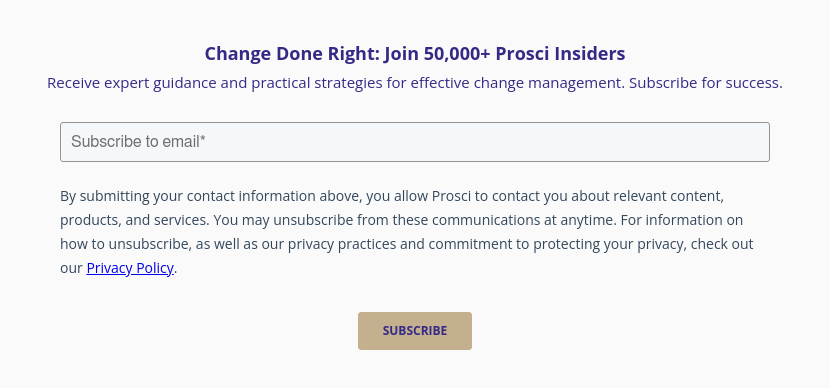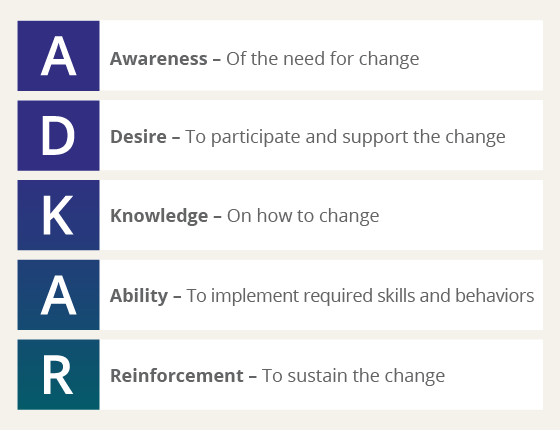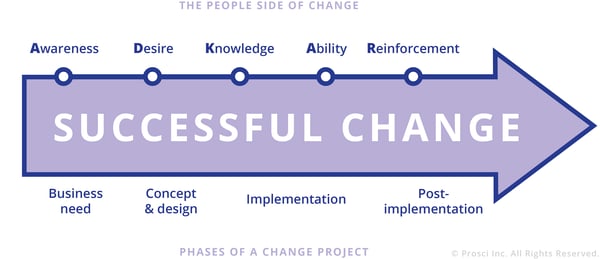Why You Need an Individual Change Model

4 Mins
Updated: August 27, 2025
Published: February 15, 2023

When we think of change management, we typically envision the actions we take, such as communicating, building sponsorship, managing resistance, etc. However, one of the keys to successfully managing change is using an individual change model. That's because understanding how an individual experiences the change is critical for change management activities and interventions to take hold. The Prosci Methodology uniquely orients the activities and interventions of change management around an individual model for change to improve outcomes.
Change From the Individual Perspective
An individual model for change is necessary for organizational change management to be effective. It defines the outcomes or results that organizational activities are trying to achieve. Ultimately, an individual change model is critical because:
1. Successful organizational change only results when individuals are successful at change
How valuable is a new process no one adopts? How valuable is a new web-based tool no one uses? How valuable is an ERP if no one is using it correctly? The answer to these questions is the essence of why organizational change is only successful when each impacted individual makes their own successful transition.
In fact, a poorly managed change can actually have severe adverse impacts. Consider a story about a man working in a warehouse. The system was telling him he could not ship product—despite the fact that it was sitting in front of him on the shelf. A customer was being deprived of a product because someone upstream had not used the new ERP system correctly. Any organizational initiative that impacts how people do their jobs is only as successful as each employee making the personal change.
2. Human beings respond to change in predictable ways
At first glance, you might say, "Oh no, we're all unique." And you're correct. However, the way we as human beings respond to change is very similar. For instance, it's basic human nature to be curious about why a change is happening and what led up to the need for change. An individual change model provides the key building blocks for successful individual change, which leads to successful organizational change.
3. Given the principles above, we can connect the
individual change model to achieving organizational goals and objectives
What we may consider the "soft issues" during change are actually at the core of meeting project goals and strategic initiatives. That's why an effective individual change model, like the Prosci ADKAR Model, describes what successful change looks like from the individual's perspective.


Risks From Ignoring the Individual Perspective
There are a number of risks involved in attempting change management without first having a solid understanding of how individuals go through change. This is perhaps one of the biggest shortcomings of "recipe-driven" change management approaches. We can't think of change management as merely checking the box and moving forward. Because of principle 1 above, we must focus on how well each individual moves through their own personal transition for change management to be successful.
Two major risks of trying change management without an individual change model include:
1. We do the activities, but don't focus on the individuals experiencing change
The individual change model defines the outcome we are trying to achieve when we implement change. Without this individual perspective, project teams run a significant risk of completing activities without achieving intended results. In the face of significant resistance, a team might say, "but we sent 43 communications" or "everyone went through the training program." This amounts to doing change management activities without focus on what the activities were trying to achieve.
2. We have no way of knowing if we have succeeded
Because the individual change model describes the desired outcomes, it also establishes a framework to know if we have been successful. Without the individual change model, it's impossible to tell whether or not change management activities are achieving desired results.
Applications of the Individual Change Model
Prosci's ADKAR Model has proven so effective that we leverage it in our Change Management Certification Program, Leading Your Team Through Change Workshop, and Change Management Sponsor Briefing. Our clients are very successful when they get each of these very different groups thinking about change in terms of the ADKAR Model.
The individual change model has several practical applications:
It focuses organizational change management activities
Individual change models provide focus for the numerous change management activities we complete. For example, it's commonly accepted that communication is critically important to succeeding at change. But what should we communicate about? In the absence of an individual change management model, project teams resort to telling others what they have been doing, describing the solution in detail. The ADKAR Model re-orients the focus from communicating to building awareness, or from training to building knowledge. This seemingly subtle shift in perspective is what differentiates mediocre change management from exceptional change management. It's what enables project and change teams to truly achieve results.

It provides direction for measuring effectiveness and for corrective actions
How do we know if our change management activities are working? For change management teams, an individual change model like the ADKAR Model enables them to collect data from different groups across the organization to 1) understand how effective their organizational change management activities have been and 2) take corrective action.
For example, if the team identifies low awareness of the need for change, they can adjust the communication plans and sponsor plans to correct this situation. If, on the other hand, knowledge and ability are low, they can adjust the training and coaching plans. Without focusing on the outcomes described in an individual change model, it's not always clear what actions to take. The individual change model provides a way to assess where individuals are in the change process and how to help them move forward.
It gives managers and supervisors a real tool to use when coaching employees
An individual change model provides managers and supervisors a tool for managing change at an individual level, which is the essence of coaching an employee through change. If we want our managers to have effective conversations with employees about a change, we must equip them with the tools they need. Teaching them about the ADKAR Model and how to use it with their employees prepares them to fulfill their role in making change successful.

It serves as an effective tool for both project and non-project changes
Not all change in organizations take place in the context of a project. Each and every day, employees, supervisors, managers and senior leaders face change. An individual model of change gives them a tool that can be used to manage these non-project changes.
Connect the Individual Change Perspective
to Your Project
The individual perspective of change is critical to any change initiative, and an individual change model is critical to moving individuals through the change with success. As you reflect on this article, remembering the key principles, risks and applications above will help you manage the significant impacts that emerge from the core of any change initiative: the individuals.



